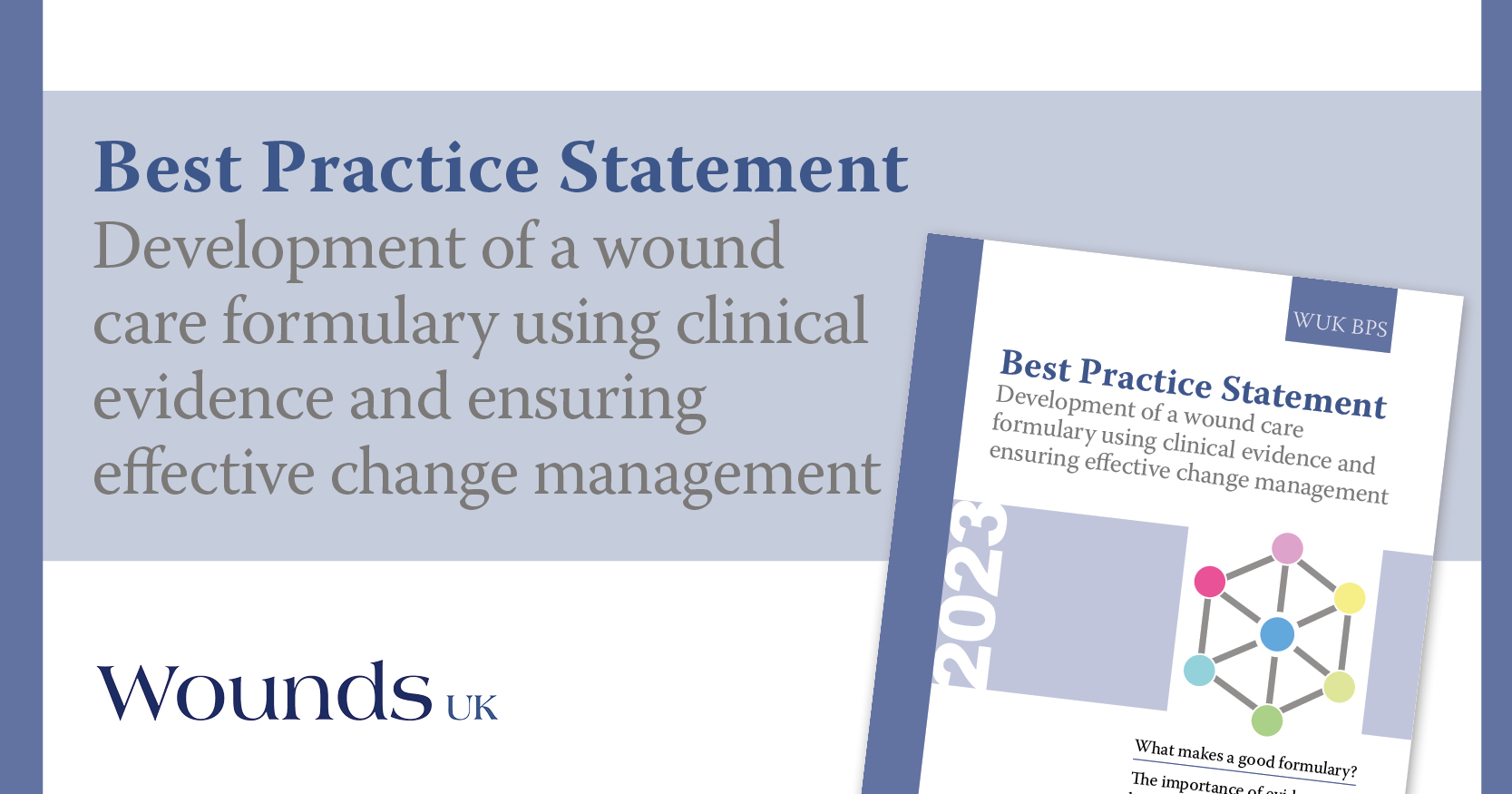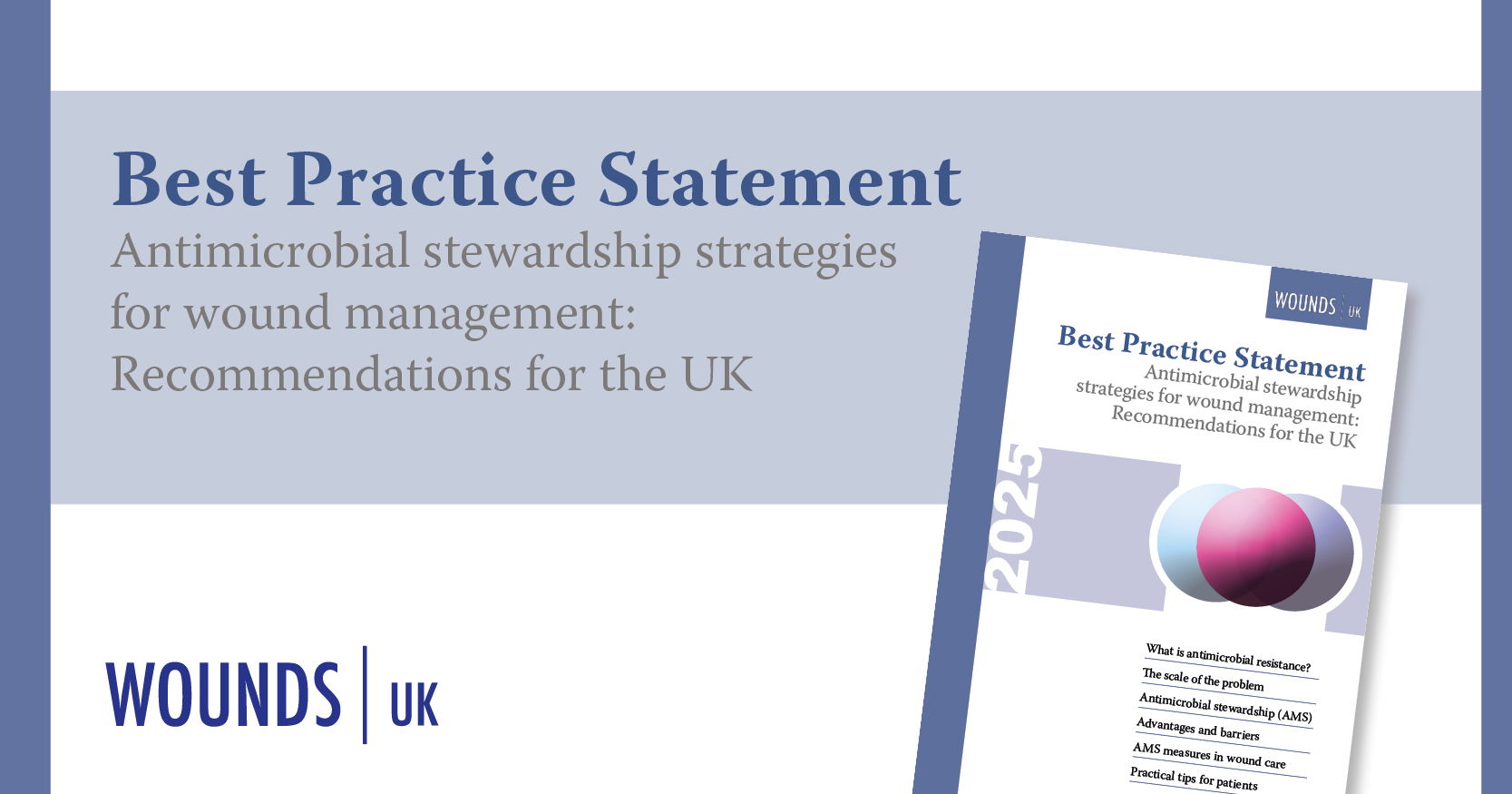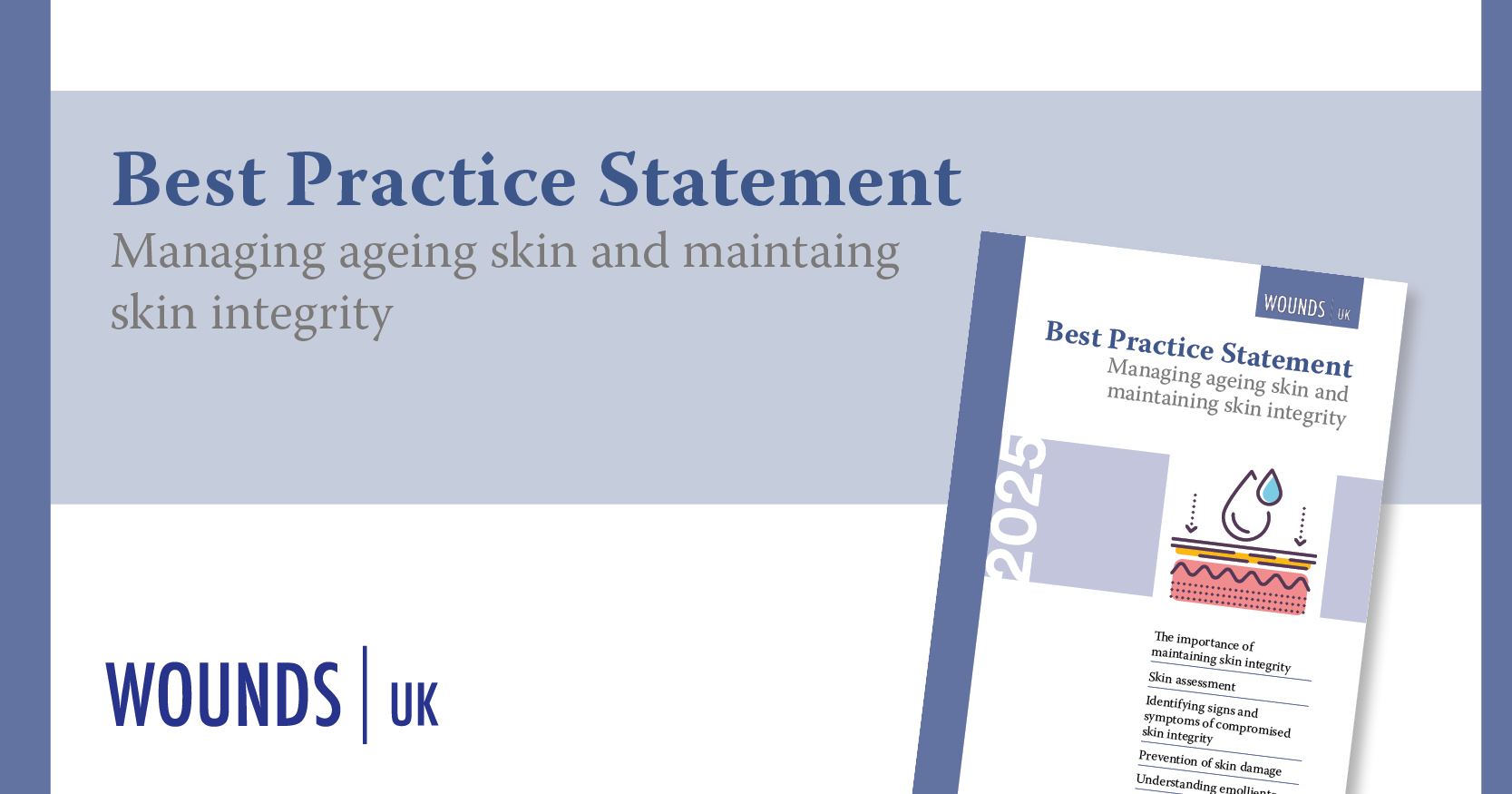ReferencesAbu-Baker NN, AbuAlrub S, Obeidat RF, Assmairan K (2021) Evidence-based practice beliefs and implementations: a cross-sectional study among undergraduate nursing students. BMC Nurs 20(1): 13
Atkin L, Tickle J (2018) Best practice statement leg ulceration pathway: revision required to reflect new evidence. Wounds UK 14(4): 58-62
Atkin L, Bućko Z, Conde Montero E et al (2019) Implementing TIMERS: the race against hard-to-heal wounds. J Wound Care 23(Sup3a): S1-S50
Bussey-Jones J, Genao I (2003) Impact of culture on health care. J Natl Med Assoc 95(8): 732-5
Chapman N, Hudson K (2021) Making the case for nurses’ increased involvement in NHS procurement. Nursing Times 117: 25-7
Connor L, Dean J, McNett M et al (2023) Evidence-based practice improves patient outcomes and healthcare system return on investment: Findings from a scoping review. Worldviews Evid Based Nurs 20(1): 6-15
Dabiri G, Damstetter E, Phillips T (2016) Choosing a Wound Dressing Based on Common Wound Characteristics. Adv Wound Care (New Rochelle) 5(1): 32-41
Department of Health (2015) Culture change in the NHS: applying the lessons of the Francis Inquiries. Available at: https://assets.publishing.service.gov.uk/government/uploads/system/uploads/attachment_data/file/403010/culture-change-nhs.pdf (accessed 12.07.2023)
Department of Health and Social Care (2012) Review of local formulary processes to support Innovation Health and Wealth. Available at: https://www.gov.uk/government/publications/review-of-local-formulary-processes-to-support-innovation-health-and-wealth (accessed 15.05.2023)
Dissemond J, Malone M, Ryan H et al (2022) Implementation of the M.O.I.S.T. concept for the local treatment of chronic wounds into clinical practice. Wounds International 13(4): 34-43
Dowsett C, Nichols J (2021) 3D: a new educational framework to improve care for patients with leg ulcers. Wounds UK 17(1): 78-83
Dreier L, Nabarro D, Nelson J (2019) Systems Leadership for Sustainable Development: Strategies for Achieving Systemic Change. Available at: https://www.hks.harvard.edu/sites/default/files/centers/mrcbg/files/Systems%20Leadership.pdf (accessed 03.10.2023)
English M, Ogola M, Aluvaala J et al (2021) First do no harm: practitioners’ ability to ‘diagnose’ system weaknesses and improve safety is a critical initial step in improving care quality. Arch Dis Child 106(4): 326-32
Falanga V (2000) Classifications for wound bed preparation and stimulation of chronic wounds. Wound Repair Regen 8(5): 347-52
Gray MJ, Wholey W-Y, Jakob U (2013) Bacterial responses to reactive chlorine species. Annu Rev Microbiol 67: 141-60
Gray TA, Wilson P, Dumville JC, Cullum NA (2019) What factors influence community wound care in the UK? A focus group study using the Theoretical Domains Framework. BMJ Open 9(7): e024859
Grothier L (2018) What are the challenges for community nurses in implementing evidence-based wound care practice? (part 1). Wounds UK 14(4): 18-23
Guest JF, Ayoub N, McIlwraith T et al (2017) Health economic burden that different wound types impose on the UK’s National Health Service. Int Wound J 14(2): 322-30
Guest JF, Fuller GW, Vowden P (2020) Cohort study evaluating the burden of wounds to the UK’s National Health Service in 2017/2018: update from 2012/2013. BMJ Open 10(12): e045253
House of Lords (2017) NHS: Wound Care. Available at: https://hansard.parliament.uk/lords/2017-11-22/debates/6C57E65A-A04D-449B-82E9-C836F088A696/NHSWoundCare (accessed 12.07.2023)
Jani A, Pitini E, Jungmann S et al (2019) A social prescriptions formulary: bringing social prescribing on par with pharmaceutical prescribing. J R Soc Med 112(12): 498-502
Kaini BK (2013) Healthcare governance for accountability and transparency. J Nepal Health Res Counc 11(23): 109-11
Kamper SJ (2020) Generalizability: Linking Evidence to Practice. J Orthop Sports Phys Ther 50(1): 45-6
Kendall M, Enright D (2012) Provision of medicines information: the example of the British National Formulary. Br J Clin Pharmacol 73: 934-8
LeBlanc K, Campbell K, Beeckman D et al (2018) Best practice recommendations for the prevention and management of skin tears in aged skin. Wounds International
Lindholm C, Searle R (2016) Wound management for the 21st century: combining effectiveness and efficiency. Int Wound J 13: 5-15.
Mannion R, Davies H (2018) Understanding organisational culture for healthcare quality improvement. BMJ 363: k4907
Melnyk BM, Fineout-Overholt E (2019) Evidence- based practice in nursing & healthcare: A guide to best practice (4th ed). Lippincott Williams & Wilkins
National Institute for Health and Care Excellence (2015) Developing and updating local formularies. Available at: https://www.nice.org.uk/guidance/mpg1/evidence/full-guideline-pdf-549570061 (accessed 15.05.2023)
National Institute for Health and Care Excellence (2023a) Technology appraisal guidance. Available at: https://www.nice.org.uk/about/what-we-do/our-programmes/nice-guidance/nice-technology-appraisal-guidance (accessed 15.05.2023)
National Institute for Health and Care Excellence (2023b) Medical Technologies Evaluation Programme. Available at: https://www.nice.org.uk/about/what-we-do/our-programmes/nice-guidance/nice-medical-technologies-evaluation-programme (accessed 04.10.2023)
NHS Digital (2019) National Diabetes Foot Care Audit Fourth Annual Report. Available at: https://www.hqip.org.uk/wp-content/uploads/2019/05/National-Diabetes-Foot-Care-Audit-fourth-annual-report-FINAL.pdf (accessed 03.10.2023)
NHS England (2017) The How-to guide for measurement for improvement. Available at: https://www.england.nhs.uk/improvement-hub/wp-content/uploads/sites/44/2017/11/How-to-Guide-for-Measurement-for-Improvement.pdf (accessed 17.07.2023)
Raepsaet C, Alves P, Cullen B et al (2023) The development of a core outcome set for clinical effectiveness studies of bordered foam dressings in the treatment of complex wounds. J Tissue Viability 32(3): 430-36
Sackett DL, Rosenberg WM, Gray JA et al (1996) Evidence-based medicine: What it is and what it isn’t. BMJ 312: 71-2
Schultz GS, Sibbald RG, Falanga V et al (2003) Wound bed preparation: a systematic approach to wound management. Wound Repair Regen. 11 Suppl 1: S1-28
Scraggs E, Brereton L, Newbould J et al (2012) Factors that encourage or discourage doctors from acting in accordance with good practice. Available at: https://www.gmc-uk.org/-/media/gmc-site/about/barriersandenablersofgood-practicefinalresearchreportpdf50388604.pdf (accessed 03.10.2023)
Shafaghat T, Zarchi MKR, Nasab MHI et al (2021) Force field analysis of driving and restraining factors affecting the evidence-based decision-making in health systems; comparing two approaches. J Educ Health Promot 10: 419
Song EH, Milne CT, Hamm T et al (2020) A novel point-of-care solution to streamline local wound formulary development and promote cost-effective wound care. Advances in Skin and Wound Care 33(2): 91-7
Song EH, Milne CT, Kuplicki S et al (2019) Streamlining the development and maintenance of a local wound care formulary. Available at: https://s3.amazonaws.com/HMP/hmp_ln/imported/2019-06/14-18_TWC0619_Song.pdf (accessed 17.05.23)
Stephen-Haynes J (2013) Development of an algorithm as an implementation model for a wound management formulary across a UK health economy. J Wound Care 22(12): 692, 694-6, 698
Veenstra GL, Ahaus K, Welker GA et al (2017) Rethinking clinical governance: healthcare professionals’ views: a Delphi study. BMJ Open 7(1): e012591
Webster P (2016) Consensus mounts for national drug formulary. CMAJ 188: E180
World Health Organization (2023) Health innovation for impact. Available at: https://www.who.int/teams/digital-health-and-innovation/health-innovation-for-impact#:~:text=WHO%20defines%20health%20innovation%20as,to%20accelerate%20positive%20health%20impact (accessed 12.07.2023)
World Union of Wound Healing Societies (2020) Optimising wound care through patient engagement. Wounds International
Wounds UK (2016) Best Practice Statement: Holistic management of venous leg ulceration. Wounds UK
Wounds UK (2021) Wound bed preparation: Made Easy. Wounds UK
Yeung K, Basu A, Hansen RN et al (2017) Impact of a value-based formulary on medication utilization, health services utilization, and expenditures. Med Care 55(2): 191-8





